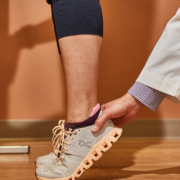Computer Science x Human Performance
By Brigid Reidy
Artificial intelligence and machine learning have taken the world around us to new heights. We find these systems operating in the background of some of our most loved and appreciated products such as at home smart-speakers, ride-booking apps, social media, and even google translate. In the past year these branches of computer science have begun to enter our world in another way as well, namely in the area of at home fitness.
Last year, Peloton launched the Peloton Guide, a machine learning and computer vision-backed camera that helps to guide the user through the strength based portions of the Peloton platform. The camera is equipped with: a movement tracker that locates and records you wherever you are in the room, ‘Self Mode’ which helps you view your form in comparison to the instructors so you can ensure you are safely executing the exercises, ‘Body Activity’ which recommends workouts based on the muscles groups you worked in previous classes and what you should focus on next, and voice activation so you can control the class without having to reach for the remote mid-bicep curl.
Peloton is not the only company utilizing computer sciences in the fitness space. Tempo, another at-home fitness company, utilizes Microsoft’s Azure Kinect DK, a 3D motion sensor and artificial intelligence software, to provide constant feedback on form during classes. Think, personalized trainer but without the person. This software is akin to the now discontinued Microsoft Kinect for Xbox One that aimed to provide users with a fully immersive at-home gaming experience by allowing the games to be remote control free and instead used computer vision to track the players movements as game controls. The newest program, utilized by Tempo, has functionality that allows for the system to provide weight recommendations for specific exercises, count your repetitions, and even provide detailed stats on your progress in form, pace, strength gains and more.
Although both systems are in their early phases, they offer a promising solution for those that want to get started with strength training at home by clearly offering cues for proper form and organizing a user’s strength plan that helps to evenly target all areas – I for one could definitely use the reminders to do my upper body exercises. The beauty of machine learning being behind these products too means that with continued use, they’re only going to get better at providing recommendations and insights into our training regiments.
What’s more exciting is that these are only two examples of a plethora of systems that are using computer science to improve health and performance. While we can’t get into all the ways artificial intelligence is helping us to advance, there are several research projects underway at companies such as Sparta Science, and Stanford research groups like Stanford Medicine’s Clinical Excellence Research Center, and Stanford Medicine’s Partnership in AI-Assisted Care that are using machine learning and computer vision to enhance lives.
Sparta Science, is a software company that utilizes artificial intelligence, machine learning, and data science to evaluate movement and provide preventative diagnostics in healthcare and sport. The company visualizes its users through a different mechanism from Peloton and Tempo. Instead, Sparta has created a force plate that measures a whole host of movement and stability areas once the user steps on. Both means of data collection, force plate or the previously discussed cameras, are aimed at recognizing inefficiencies and improving performance outcomes. Most notably, Sparta Science has been able to use computer systems to track athletic performance and decrease risk of sports-related injuries. With this data, the athlete is then able tailor training to improve risk areas and track improvements over time. In the realm of preventative healthcare, their systems are able to detect deficiencies in movement and movement disorders, create custom treatment plans, and similar to the work with athletes, track improvements over time. This may have specific applications for aging populations as evaluating stability and movement can be a useful tool in assessing risk areas, such as fall risk, and allowing the individual and their healthcare providers to determine a plan for improving performance and maintaining independence.
Another group utilizing AI to help the aging population is Stanford Medicine’s Partnership in AI-Assisted Care. This group is currently conducting research in Senior Care, with the goal of using machine learning and computer vision to help the aging population maintain independence and continue living at home as opposed to a senior care facility. Through installation of a few sensors in the home, researchers are using computer vision to analyze 17 key activities such as slowed movement, eating periods, sleep, unstable transfer while walking, chair and bed immobility, detecting falls, and notifying expert assistance when needed or when risks are detected. These sensors utilize similar machine learning and activity detection as we have discussed in the fitness space for improving training and performance. This design is being put into practice too. Through human centered design, Stanford’s AI for Eldery Care and the Stanford Thailand Consortium, are implementing these sensors to improve the performance and safety of the aging population in Thailand – and depending on the outcomes of this study, possibly the aging populations around the world.
Science-fiction movies have made advancements in artificial intelligence look far too similar to a modern day Frankenstien. But, as we’ve discussed, AI is much less terrifying and in fact, proving to be potentially game changing in the world of athletic training and improved aging. Though these user interfaces and research studies are still in early stages, machine learning gives them the capability to rapidly develop and offer great benefit to so many age groups and all kinds of performance goals.


